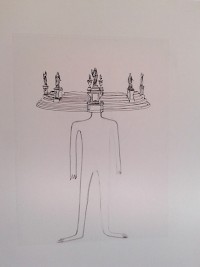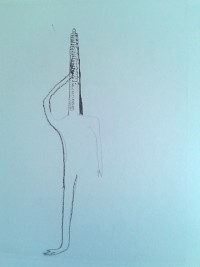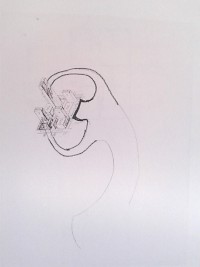Marta Jecu: What is the role/the position of the human presence, which you suggest in your work, the connection of the human agency with the potentialities of space and time, which you are working on? The human actions seem to me to occupy a back-stage position in your work. Humans have an agency but remain unseen: for instance you build and deconstruct but the audience doesn't feel your presence. You work often on human habitation sites, which imply a lived experience, on urban environments or on other constructions (which are all an outcome of human creation processes) but humans and their activities do not seem to leave their traces.
Carlos Bunga: The process of human creation is part of our actions as a state of both instinctual and rational impulses, that cohabit the same cycle of time, and emerge on different levels of action. The rational matter is in dialogue with the intuition or the impulses, like a sort of action potential, which is able to coordinate activities. .
The construction and deconstruction of spaces is a cyclical process, in permanent transformation, which is fundamental for the ecosystem of living organisms, and results from the interaction between elements. Architecture and its significance, isn't based merely on construction processes in itself, but instead on an adaptation of these construction processes through- and their co-existence with the human being, which implies a set of changes and alterations of its substance. Human beings do not only live or move in architectures, but carry themselves the structure of an organism or system, that deals with the form and the transformations of the organic world and its beings. These transformations are implicitly related with the idea of time in human actions, and have the effect of potentiating space, that can therefore both include a lived experience and be experienced as a state, which bears a process.
M. J.: What role does virtuality play in the economy of your work and why? What does the virtual potential of your work consist on?
C.B.: The economy of the means, which I involve in my work, is profoundly related to the realization of works, with different tools. We are surrounded by daily objects and stimuli with a great symbolic charge, permanency, stability, solidity or which are stereotypical. What I am interested in, is the possibility of a multifaceted thinking about a universe, which is constituted by objects that can have more open and ambiguous meanings. The variation of ideas and forms, are the means in the processes, in which my works are involved, and which are meant to allow a great flexibility in the manner of understanding the world.
Virtuality implies an idea of simulacrum or of intermediary terrains, starting from a real referent, but which suffered an intervention and is seen as a potential. Virtuality establishes in my work relationships between ideas on time and space, especially regarding experimentation on the always present erosion and entropy and their causes and capacities. Virtuality is also connected to a permanent consciousness of the vulnerability of objects.
M. J.: What could be the connection between the virtuality and the new (as an outcome of art)?
C. B.: Virtuality creates relationships between different usages and between different coordinates of objects, which allow the possibility of showing new perspectives of the way of understanding objects and new contexts of exchange and communication with the object. Virtuality emerges as a necessity regarding the relation real/unreal: it can eliminate the frontier, which exists between both of them. The connection with the new, can be made through the intermediary spaces, which exist between things. In connection to this, is placed the artistic production, which can become a creation space, and which can assume those intermediary spaces, that enhance new possibilities of thought and experimentation. These relationships can produce mutual influences, originating ruptures of frontiers.
M.J.: Your works are site-specific. Are you interested in an implementation of your work in a certain environment, in the history and social environment where it is exhibited? Or are you rather interested in showing in an abstract way certain mechanisms?
C. B.: My works are made in different media, taking elements from the environment as well as from the history of places and their social implications. Many of my works are made starting from a real referent, but are shown in a way, that can contain different levels of abstraction. My work is strongly connected to the ideas of absence and emptiness or rests, which enhance other notions, such as the force of suggestion and potentiality.
This manner of understanding the objects allows space for questioning. They are open works, which give the possibility to more flexible understanding of the way of thinking about- and relating to the objects. The abstract mechanisms raise uncertainties, since they lack concreteness in regard to particular cases. Our thinking is structured between codes, categorizations or ideologies in the mental processes of grasping our surroundings.
We inherit a tradition of thinking in the way we relate to the world. And so there exists a need of constant renovation and transformation in the way we adapt to- and understand the ecosystem.
M. J.: Your work is, the way you explained, mainly concerned not with demolition and destruction, but mostly with their staging, their provocation, as in a laboratory. You said in another interview, it is about simulation. You collect your postcards and newspapers as the real events? Are you interested in their belonging to reality and describing a state of <post> with its entire catastrophic atmosphere – contrary to the simulations in your work? Or, on the contrary, do you consider them like your works too, also a representation: decay in time filtered through a medium? So are you interested in their mediality or in their content/realness?
C. B.:The demolition and destruction of the objects are present in our discourses and in our categorizing understanding of the mechanisms of these two actions. Demolition and destruction are relating to a work, which develops through constant processes, and whose field of actions can be a sort of laboratory, where there exists constantly some staging of these open processes.
This processual laboratory induces us into the study of real referents in an unreal space, where actions take place in the virtuality of the two states of demolition and construction.
A simulacrum gives the possibility of projecting these codes of the real world into the work process, in an attempt of understanding or making visible, components, situations or reactions, which are previously not activated or which pass without being perceived.
It is necessary that there exist objects or documents like post-cards, journals or real historic facts, which can be brought into the laboratory – which can also be a mental space – and are processed in this intermediary space of personal or collective experience. Between the two (the real space and the mental laboratory) takes place a constant process of meaning exchange while the objects/documents are being involved in an active way. These (documents, newspapers, objects) are part of the past /the history and function as artefacts or as fragments in a state of decomposition.
The processual state of objects tends to be a place in constant transformation and subjected to questionings, so that there is no finalized form in their structure. Any finalized form induces a meaning of death and, as a consequence, the process of its restoration comes out as a necessity of perpetuating the form, through its memory of time. Great catastrophes accelerate the temporality of the objects and this is strongly related with this performative side present in many of my realized works.
Either in a bodily dimension or regarding small quotidian gestures, the temporal acceleration is present on various levels of time and space. The decadence is permanently active in any medium, which is developing in time, and is strictly related with the idea of death. Nevertheless, it brings a cyclical notion of the processes in which things are caught and brings a direction of time, involved in constant processes of transformation and rebirth.
M. J.: How do you find the manner of journals, postcards etc. documenting a disaster, different /similar to your way of using documentation, in your own work?
C. B.: The documentation is related with the virtual because they both are based on records that belong to the past and help us understand the future. This virtuality of the record of historical events, in the work that I develop, is for me a constant presence in my working process. Between the past (documentation) and the future (virtuality) there is this mutual reflection: the experience of the present (the laboratory space).
In this intermediary temporality of every process, which develops in cyclical movement, the different times of the History interconnect. Therefore in the laboratory there is the possibility of transforming ecosystems: we can add, subtract, multiply, correct, restore or accelerate.
M. J.: Your works do not represent, they suggest on a more conceptual level, their content. Still, by which means do you make experience-able this unrepresentable in your work?
C. B.: There has always been this tendency to- and a consciousness about trying not to represent but, starting from a referent from reality, with the intention of showing it, to fragment its representation and to transmit its meaning in a more conceptual or abstract way. This manner of showing things opens a mental space more open to different readings, which makes it possible to variate models of thought and understanding. The reflections hold implicitly the referent of reality but are shown in my work, as fragments of a much more complex structure, which is not experienceable in the real time. Since the concepts encompass a dimension, different from the one in which the objects are situated, the objects can become a pretext of dialogue in time with many interrelated concepts. The unrepresentable can raise abstract questions on reality and can raise questions about practices of categorizing objects and about their permanency. The unrepresentable can have as referent not only objects, but also the domain of the thought.
M. J.: The virtual is now so much connected to the digital media. But you construct also a virtuality with completely other means. In what lies the specificity of your modality of suggesting the virtual?
C. B.:The virtual is concretely connected to digital media in relation with the time/space that we know and in which we live. Technology is an integral part of a society, where always something ends by missing and where the existence of the objects is also related to the appropriation of images as an exercise of a constant approximation of reality by technology. From these relations emerges artificiality: the reality like a screen projection – a new reality that came through technology.
Virtuality is present in the overall processes of my work and is present also in the material that I use, which is characteristic for my working process – the cardboard. Cardboard is an industrial object, resulting from a society of consumption, of mass culture, of trends, of emigration, of different languages, perceptions and carries with it the social and political function of “the world in the era of technical reproductibility”. What I make in my work visible is a transformation of experience, that relates to the degradation or to the ephemeral side of a construction. This process of degradation of the ephemeral, which belongs to an artificial or virtual reality, is connected also to a temporal dimension of the instant experience, of perception and of knowledge.
I use cardboard, but I do not speak about cardboard. Cardboard functions as a medium for taking into consideration languages and reflections, which have as a background the referent time/space or real/unreal.


